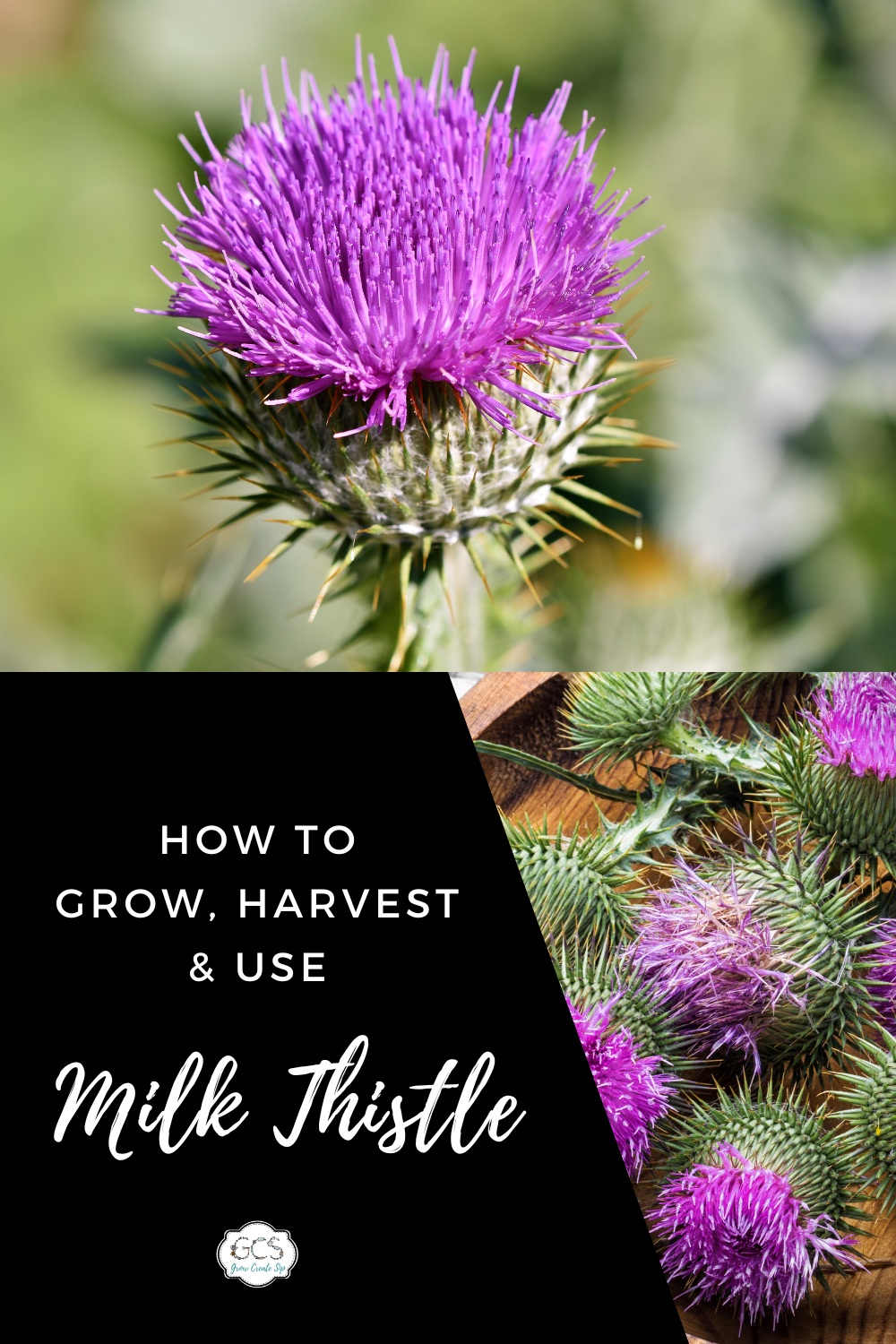How to Grow, Harvest, and Use a Milk Thistle Plant
May 12, 2025
Milk thistle is one of my favorite medicinal herbs. Some of its best medicinal uses include liver support, digestion, and gallbladder health. These systems are highly critical to making sure that we are healthy all over.
I’ll be honest with you: milk thistle is not necessarily a plant you would think of as tasty, but it is super versatile with its uses and is packed with benefits too. Even though the milk thistle plant is not the most popular or highest-rated plant in the landscaping community, I believe it is an herb that everyone should know about… dare I say, even grow.
Growing milk thistle allows you to access natural medicine straight from your own garden. While you can certainly use a milk thistle plant to make tea, it is best used in the form of a capsule or tincture. In this guide, you will learn about how to plant and harvest milk thistle, as well as how to make your own milk thistle capsules.

The Legal Stuff
This blog is provided by St. Fiacre's Farm LLC for informational purposes only. It does not constitute medical advice, and you should always seek the advice of a qualified healthcare provider for any medical questions or concerns.These statements have not been evaluated by the Food and Drug Administration. This product is not intended to diagnose, treat, cure, or prevent any disease. Please note that we may earn a small commission on any purchases you make through our affiliate links, at no additional cost to you. Thank you for your support!
What is Milk Thistle?
Milk thistle is a flowering herb that belongs to the Asteraceae family. This tall-growing plant is known for its green and white leaves, its bright purple flowers, and its sharp, spiny edges.
The official botanical name for this plant is Silybum Marianum, but it is sometimes also referred to as Mediterranean milk thistle or Mary thistle –– named after Mary, the mother of Jesus. It is native to the Mediterranean region and parts of Europe, Asia, and Africa.
What is milk thistle used for?
Milk thistle has many health benefits, including the following:
- Antioxidant
- Anti-inflammatory
- Supports gallbladder health
- Promotes digestion
- Supports heart health (by reducing bad cholesterol)
- Improves insulin sensitivity
There are multiple ways that you can consume this herb to get its health benefits. Milk thistle can be used to make tea, salves, tinctures, and capsules.

Liver benefits from the milk thistle plant
Milk thistle’s specialty is liver support. You can think of the liver as the filter of the body — just as you need to change the filter on a car, you need to make sure your liver is clean and in good working condition too. Otherwise, we recycle the junk in our bodies and continue to get sicker and sicker.
The ingredient in milk thistle that supports liver function is called silymarin, which is extracted from the seeds of the plant. Silymarin is thought to help the liver with detoxification, protect against cell damage, and also help reduce inflammation (Source).
Growing Milk Thistle
Milk thistle is a biennial plant, meaning that its full life cycle lasts about two years from the time it is seeded to the time it has fully matured. I hear ya… that sounds like a long time! While there is a bit of waiting involved, the process is much simpler than you might expect. Milk thistle plants are actually very easy to grow. They require very little care and watering once planted. I promise it’s worth the time that you will put in, especially because of the health benefits.
One of milk thistle’s most favorable qualities is that it is drought-resistant. These plants do best in well-drained soil but are highly adaptive to different conditions. They are able to tolerate poor or rocky soil conditions.
To reach their full growing potential, milk thistle plants should have access to full sun. Because they thrive in mild to warm climates, we recommend beginning planting in the springtime for best results.

Tips for milk thistle planting
When growing milk thistle, the spacing is super important. It’s best to leave 12 to 18 inches between each plant so that they have plenty of room to grow.
We prefer to plant milk thistle seeds outdoors. Although a milk thistle plant potted in doors would make a great conversation starter, wouldn't it? Here are the steps to take — you can expect the seeds to germinate within approximately three weeks.
- Prepare a well-drained soil bed in a location that will get plenty of sunlight.
- Sow your seeds one-quarter of an inch deep, covering them lightly with soil.
- Water lightly after planting so that the soil is moist but not soggy.
Watering and maintenance
Since milk thistle is drought-resistant, you can reduce watering once you have passed the germination and seedling stages.
In general, watering once a week or every other week should be enough. Just keep in mind that you may need to adjust this frequency if you are growing milk thistle in a more hot, dry climate.
To promote healthy growth, be sure to keep the area free of weeds. It’s also a good idea to deadhead your milk thistle plants before they mature fully and produce more seeds. This will help prevent any excess or unintended spreading. Unless of course it is the seeds that are you are after - then wait until the seeds have fully matured.
Harvesting, Processing, and Using a Milk Thistle Plant
One of my favorite things about this plant is that each part serves a purpose, including the leaves, flowers, and seeds. A word of caution though: milk thistle plants come with some prickly points, especially when you are harvesting the seed out of its pokey tops. We highly recommend wearing protective gloves when harvesting and handling milk thistle.
Harvesting
You can harvest at different stages depending on which part of the plant you want to use.
- Leaves: You can harvest milk thistle leaves at any time, but younger leaves will be more tender and fresh. Use a pair of shears to carefully cut the leaves at the base. Once you remove the sharp spines from the leaves, they can be used for various culinary purposes. Milk thistle leaves can be eaten raw in salads, cooked like spinach, steeped for tea, blended into smoothies, added to soups, made into pesto, or used as wraps, but they should be de-spined first to remove their prickly edges.
- Flowers and seeds: The purple flowerheads are where the seeds are located. Because the seeds will fall and spread once the flowers are fully opened, the best time to harvest is before the plant is in full bloom. Milk thistle flowers can be used to make herbal tea, infused into honey or vinegar, eaten raw in salads, or cooked like artichokes by steaming the buds and removing the prickly parts.
Processing
To process milk thistle seeds, start by drying out the flower heads. You can do this either by hanging and air drying them, or by using a dehydrator. Once the heads have dried, crush them to release seeds. From there, you can process the seeds even further by grinding them into a powder.

Culinary uses for milk thistle plants
A cup of milk thistle tea is so relaxing and is packed with natural healing benefits. It is easy to make and only takes a few minutes to prepare. All you need to do is steep the leaves or seeds in boiling water, then strain the solids and enjoy.
Making your own milk thistle capsules
Although milk thistle is not the most common herb out there, we believe everyone should have some on hand because of its health benefits. Of course, we encourage you to grow your own milk thistle so that you can have a source of natural medicine in your garden, but you can also buy it if you prefer.
Be on the lookout for our Farmhouse milk thistle herb, which we will be selling in bulk soon! Once you have some on hand, you can make your own milk thistle capsules using this capsule machine and these fillable gelatin capsules. If you are vegetarian, we also offer some natural plant fiber capsules that are 100% free from animal products.
Milk Thistle Plant Frequently Asked Questions
Are milk thistle plants invasive?
Yes, milk thistle is considered to be invasive. The plants produce a high volume of seeds, which can easily be spread through the wind or simply by falling.
Who should avoid milk thistle products?
Women who are pregnant or breastfeeding should avoid consuming milk thistle products as there has not been enough research done to determine the safety of these two situations. Though we recommend due diligence in research with a good set of herbal books when making your decision
Does milk thistle have any side effects?
Consuming milk thistle may result in side effects such as nausea, dizziness, or bloating due to its effects on moving digestive and liver contents. It is always a good idea to consult with a medical professional before adding milk thistle capsules or any other new products to your routine.
The Must-Have Liver Loving Herb
We love the milk thistle plant because of its versatile uses, and most of all, its ability to support liver health and other important body systems. It is a must-have plant in every apothecary and my first to go to for liver, gallbladder, and digestive support.
Now that you know all about milk thistle, be sure to add everything you have learned to your monograph journal, which you can download for FREE on our website! Or get the made for you printable version of the Milk Thistle Monograph in the Herbal Studio Library!
Learn More About Medicinal Plants
- Soursop Tea and What is it Good For?
- Grow, Harvest and Use Lilacs
- How to Use Saffron + Saffron Recipe
- Best Tea for Anxiety
- How to Care for Turmeric Plants
- How to Make Elderberry Syrup
















